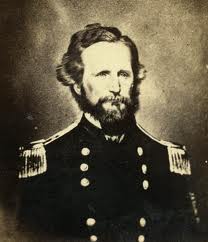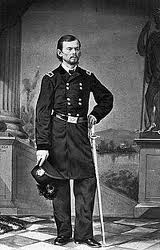 General Nathaniel Lyon’s Civil War career didn’t last long, but he became the Union’s first hero. Lyon was one of the true soldier generals of his time, knowing his limitations. This Union General found himself on the cutting edge of secession, first in Kansas and then Missouri at the beginning of the civil conflict. Politics were playing a huge role in the drama, with slavery being the divisive issue. Lyon had all the prerequisites for his leadership in Missouri. His oath of honor and duty to the United States proved that Lyon was the man and the officer, in the right place, at the right time.
General Nathaniel Lyon’s Civil War career didn’t last long, but he became the Union’s first hero. Lyon was one of the true soldier generals of his time, knowing his limitations. This Union General found himself on the cutting edge of secession, first in Kansas and then Missouri at the beginning of the civil conflict. Politics were playing a huge role in the drama, with slavery being the divisive issue. Lyon had all the prerequisites for his leadership in Missouri. His oath of honor and duty to the United States proved that Lyon was the man and the officer, in the right place, at the right time.
Nathaniel Lyon, a native of Connecticut, was born in 1813. He was appointed to the Military Academy and graduated in 1841. Lyon’s assignments included, the Seminole War in Florida, the Mexican War, Pomo Native-American Conflict in California, and a posting at Fort Riley in the Territory of Kansas. Of these varying assignments, Lyon was breveted for bravery in Mexico and reassigned after a questionable massacre of California Native Americans, in 1850. While at Fort Riley, Lyon developed a strong anti-slavery sentiment and became a staunch republican. A deadly conflict, over slavery, had been in progress for five years in “Bleeding Kansas” and Lyon stated in early 1861,
“It is no longer useful to appeal to reason, but to the sword.”
In February of 1861, Nathaniel Lyon marched his troopers to St. Louis and took command of the United States Arsenal. In March, fearing that Pro-Southern, Missouri Governor Jackson would attempt to raid the U.S. ordinance, Lyon shipped much of the stored arms secretly to Illinois, only keeping what was needed to arm the local, mainly German immigrant, militia. On May 10, Lyon and his German immigrant militia, led by Franz Sigel, surrounded the insurgents in St. Louis, at an encampment outside of the city, deemed Fort Jackson. Without a shot, the rebel encampment surrendered and began a long march back through the city to the arsenal. Unruly, pro-southern, mobs swarmed the columns and shots rang out, many civilians and a few troops were killed and wounded. The St Louis incursion and mob violence spawned additional southern sentiment, encouraging the secession movement.
In May, 1861, Lyon replaced General Harney and was promoted to Brigadier General and Department of the West command. The pro-secession and southern elements, led by Governor Jackson, met with General Lyon in June to discuss their separate agendas. After five hours of fruitless oratory, Lyon rose from his chair and stated,
“Rather than concede to the state of Missouri the right to demand that my government shall not enlist troops within her limits, or bring troops into the state whenever it pleases, or move its troops at its own will into, or out of, or through the state; rather than to concede to the state of Missouri for one single instant the right to dictate to my government in any matter however unimportant, I would see you, and you, and you, and you, and you, and every man, woman, and child in the state dead and buried. This means war.”
Many of the residents supported the “no-nonsense” approach of General Lyon, however it incensed the insurgents and the Pro-Jackson element fled St Louis, taking refuge first in Jefferson City and then in Boonville. General Lyon and his troops marched to Jefferson City, finding that Jackson’s forces had retreated to Boonville, he easily brushed aside the small rear guard there and prepared to meet Colonel Franz Sigel’s German immigrant troopers at Springfield and trap the rebel forces between them.
 Franz Sigel, a German immigrant, graduated from a military academy in his native country, found himself on the wrong side of an insurrection and fled to the United States. Sigel, who was a professor at the St Louis German American Institute and also elected Director of Public Schools in 1860, had a tremendous immigrant following in the city. President Lincoln, who was desperate for immigrant enlistment, promoted Sigel to Brigadier General, one of Lincoln’s earliest “Political General” appointments, with the results pre-ordained. General Lyon devised a plan to trap the reinforced Confederate troops south of Springfield, but Sigel insisted on dividing their forces, swinging his elements east and flanking the disorganized Southerners. Sigel and his immigrants met heavy resistance on their ill-fated foray, were routed, never reaching Lyon’s outnumbered forces southwest of Springfield at Wilson’s Creek.
Franz Sigel, a German immigrant, graduated from a military academy in his native country, found himself on the wrong side of an insurrection and fled to the United States. Sigel, who was a professor at the St Louis German American Institute and also elected Director of Public Schools in 1860, had a tremendous immigrant following in the city. President Lincoln, who was desperate for immigrant enlistment, promoted Sigel to Brigadier General, one of Lincoln’s earliest “Political General” appointments, with the results pre-ordained. General Lyon devised a plan to trap the reinforced Confederate troops south of Springfield, but Sigel insisted on dividing their forces, swinging his elements east and flanking the disorganized Southerners. Sigel and his immigrants met heavy resistance on their ill-fated foray, were routed, never reaching Lyon’s outnumbered forces southwest of Springfield at Wilson’s Creek.
General Lyon retained approximately 6000 troops, facing Confederate forces of 12,000 and on the morning of August 10, 1861, Lyon’s troops fought a valiant and noble holding action at “Bloody Hill.” General Lyon was wounded twice and had his horse shot from under him, returning to the line each time to inspire his troopers. Meanwhile, Sigel hearing the battle and assuming the worse, galloped off to Springfield, with his staff, fearing for his life. General Lyon, while leading from the front, was eventually shot through the heart, his body left on the field and his surviving soldiers retreating, in Sigel’s wake, to Springfield.
General Nathaniel Lyon, the first Union General killed in the Civil War, broke a fundamental and strategic battle philosophy, never divide your forces in the face of a superior enemy. However, Sigel being a political appointee of Lincoln and Lyon an officer and a gentleman patriot; honor, duty and country, prevailed.
Lyon’s body was eventually recovered and buried with honors in Connecticut. General Nathaniel Lyon will always be remembered for assuring Missouri’s continued allegiance and as the First Union hero.
Bummer


I’ve heard of Sigel before but don’t know much about him. What was his fate? Or am I encroaching on a future post?
Louis,
Sigel was quite the academic, schooled in the fatherland, Prussian Cavalry Trained, however the plains of Europe are alot different than the Ozarks. Guess he kicked some tail at Pea Ridge, but did not fare well at all in the Shenandoah Valley, Halleck couldn’t stand him, pared his command down to nothing and Sigel’s feelings got hurt and resigned. Lincoln played the ethnic card with Sigel and his Teutonic travelers, lots of money and votes. Sorry for being so down on Sigel, he was just pathetic. Pride and ego will kill a career every time.
Bummer